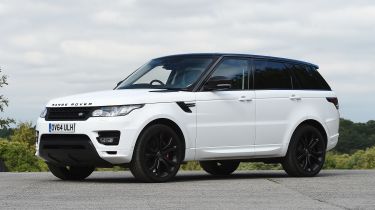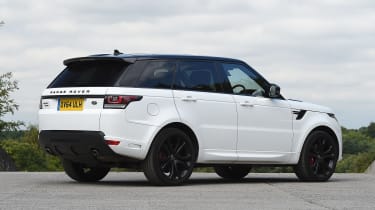Used Range Rover Sport (Mk2, 2013-2022) review
A full used buyer’s guide on the Range Rover Sport, covering the second-generation car that was on sale between 2013 and 2022
Verdict
Land Rover’s reputation for dependability has taken a bashing, thanks to the complexity of models such as the Range Rover Sport. Based on the same platform as the contemporary Range Rover, the Sport is a bit smaller and more agile, but it’s still a big car with the associated high running costs. You’ll pay plenty for fuel, road tax and maintenance, while insurance is also costly, because these cars are very popular with thieves, so decent security is another essential part of ownership. The Range Rover Sport gives plenty in return, with its off-roading, cruising and towing abilities, but which engine you go for will make a big difference to the driving and owning experience, so choose carefully.
Land Rover celebrates its 75th anniversary in 2023, and it’s fair to say that the brand has come a long way since 1948.
For many years its products were crudely engineered yet capable of going anywhere, but in the eighties there was a shift towards greater luxury (the original Range Rover was surprisingly utilitarian), and things have gathered pace since then.
The Mk1 Range Rover Sport from 2004 could climb mountains or cruise at high speed on a motorway, all in perfect luxury. The second take on the formula was even more impressive, but it was also far more complex, which had an impact on reliability. So should you buy a second-hand Range Rover Sport Mk2, or is the risk too great?
History
The second-generation Sport was launched in September 2013 with 258bhp TDV6 or 292bhp 3.0-litre SDV6 diesel engines, or a 510bhp 5.0-litre V8 petrol, each offered with an eight-speed automatic gearbox only. In November 2014 a 339bhp 4.4-litre SDV8 diesel joined the range, and in February 2015 the 542bhp supercharged 5.0 V8 Sport SVR and 335bhp SDV6 hybrid arrived.
Used - available now

2017 Land Rover
Range Rover Sport
76,710 milesAutomaticPetrol3.0L
Cash £19,795
2022 Land Rover
Range Rover Sport
55,930 milesAutomaticPetrol3.0L
Cash £35,695
2022 Land Rover
Range Rover Sport
63,010 milesAutomaticPetrol2.0L
Cash £30,595
2022 Land Rover
Range Rover Sport
93,610 milesAutomaticDiesel3.0L
Cash £29,495At the end of 2016, 2.0-litre diesel and supercharged 3.0-litre V6 petrol engines appeared, then a year later Land Rover’s first plug-in hybrid, the P400e, reached showrooms, with a 2.0-litre petrol engine.
This motor also came in 296bhp Si4 non-hybrid form, and at the same time the SVR was upgraded to 567bhp. The HST, launched in February 2019, came with a 395bhp 3.0-litre supercharged straight-six petrol engine, featuring mild-hybrid technology.
Which one should I buy?
For real-world purchase and running costs, we’d choose the SDV6 thanks to its blend of performance and economy (although fuel bills will still be high), while seven-seat cars improve usability. All Mk2 Range Rover Sports have leather trim, DAB radio, automatic headlights and wipers, a powered tailgate, climate control, heated front seats, navigation and air suspension.
The HSE adds 20-inch wheels, 14-way electric front-seat adjustment with memory, heated rear seats, powered steering-column adjustment, paddle-shift controls, a heated windscreen and a rear-view camera. The HSE Dynamic has 21-inch alloys and a twin-speed transfer box, while the Autobiography Dynamic features High-Beam Assist, configurable interior mood lighting, a premium hi-fi, adaptive cruise control and extra driver-assistance systems.
Alternatives to the Range Rover Sport
There are some tempting rivals, not least the Sport’s bigger brother, the Range Rover, along with the Range Rover Velar, which come only in five-seat form. If seven seats are key, the Land Rover Discovery might suit, while the Volvo XC90 is stylish and comfortable, but the Swedish model only comes with four-cylinder engines.
Three German alternatives that give the Land Rover a hard time are the Audi Q7, BMW X5 and Mercedes GLE; all are costly to buy and run, but feature luxurious cabins packed with technology. That’s also true of the Porsche Cayenne, which comes with five seats only, just like the BMW X6, and Mercedes GLE Coupé and Porsche Cayenne Coupé. Two less obvious choices are the Maserati Levante and Volkswagen Touareg.
What to look for
ULEZ
The Sport wasn’t Euro 6-compliant until September 2015. Cars with an AdBlue tank will be exempt from any clean-air zones.
Tyres
The original Continental tyres had a layer of foam inside to reduce road noise. It works brilliantly, but it means that punctures can’t be repaired.
Panel fit
Poor panel alignment is common, while leaks aren’t unusual from the tailgate and sunroof; both of these can cause chaos with the electrics.
Towing
The SDV6, SDV8 and 5.0 V8 editions are all rated at up to 3,500kg. But the P400e can pull just 2,500kg, while the Si4/P300 and SVR are rated at 3,000kg.
Reliability
Owners’ forums show that the Range Rover Sport can suffer from a lot of problems, some of which are expensive
to fix. Many owners have enjoyed trouble-free motoring, though, so be scrupulous with your pre-purchase checks.
Interior
The cabin is one of the reasons why you’ll want a Range Rover Sport; it’s packed with premium materials, and is very comfortable and hi-tech, but the infotainment should be much better than it is.
A third row of seats was an option (and fitted to just one car in 25) and these are cramped for adults, but rows one and two are spacious enough. Land Rover calls the seven-seat Range Rover Sport a 5+2. Also bear in mind that if you buy a seven-seater, there’s no room for a spare wheel.
In five-seat mode, the boot has a 784-litre capacity. It’s 1,761 litres with the backrests folded.
Prices
We found just over 3,000 Range Rover Sport Mk2s for sale, almost three-quarters of which were diesels, with 80 per cent fitted with the SDV6 unit. If performance is your thing, we found more than 400 SVRs on the market.
Running costs
All diesel and plug-in hybrid models must be serviced every 12 months or 16,000 miles; for petrol cars it’s two years or 21,000 miles. An oil and filter change costs £300, while new fuel and pollen filters push this towards £500.
Maintenance costs for diesel models are generally £500-£1400; the seventh service includes a new cambelt. For petrol models, every third service costs around £1,300, while the sixth service costs £1,200 for plug-in hybrids. Only the diesel engine has a cambelt, but these charges are just for fluids, belts and filters, with brakes, suspension and tyres additional.
The timing chain needs to be replaced every five years or 140,000 miles. An official dealer charges around £600, and replaces the water pump at the same time. Fresh brake fluid is needed every two years, at £70.
Recalls
The Range Rover Sport Mk2 has been recalled 22 times so far. The first action was issued within a month of the car going on sale, because of the wiring loom chafing. The most recent campaign was launched in August 2022, because of faulty seatbelt pre-tensioners.
In the intervening nine years there were a further 20 recalls, for problems as wide ranging as loose wheel nuts, the doors unlatching while on the move, airbag glitches and faulty seatbelts. Other potential issues include fuel leaks, brake servo failure, the autonomous emergency braking not working and the instrument cluster failing. Exhaust emissions could also be too high, the indicators could fail and the engine’s crankshaft pulley retaining bolt could fracture. Most of these recalls also affected other models within Land Rover’s range.
Driver Power owner satisfaction
The Range Rover Sport Mk2 only appeared in our Driver Power new-car survey in 2015, when it came 22nd out of
150 entries. The model did make an appearance in our 2022 Driver Power used-car survey, though, coming 72nd out of
75 entries. The high running costs and poor reliability (it came last for the latter) held the car back, but owners did
like the Range Rover Sport’s looks and drivetrain.
Looking to sell your current car quickly and for a good price? Try our Free Car Valuation tool today!










